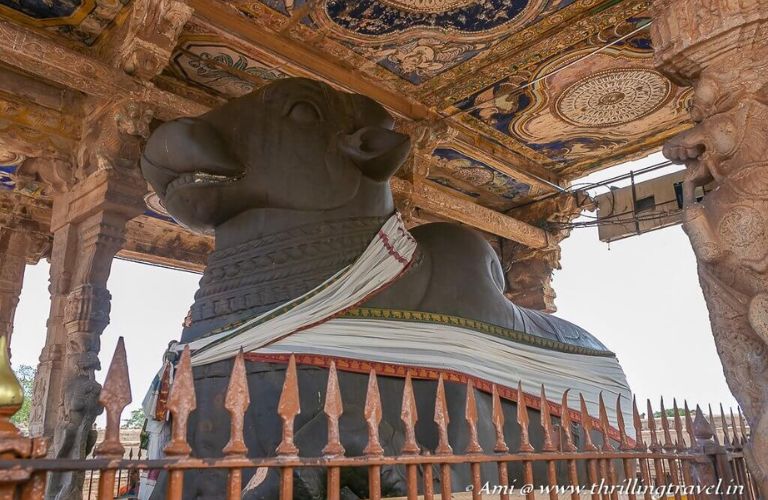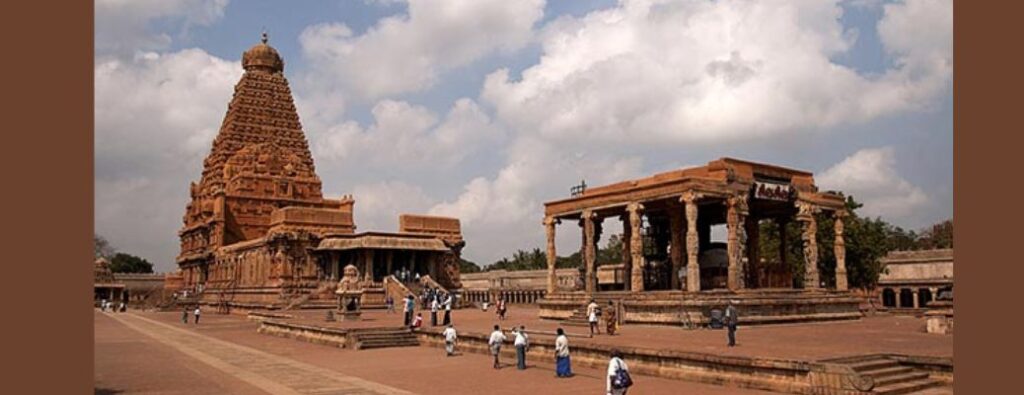What are the Secrets of the Mysterious Thanjavur Brihadeeswarar Temple or the Thanjai Periyakovil?
The Thanjavur Brihadeeswarar Temple, also known as Thanjai Periyakovil, reflects the architectural brilliance and cultural richness of ancient India. Constructed in the 11th century by Raja Raja Chola I, this magnificent temple is dedicated to Lord Shiva and is a part of the UNESCO World Heritage Site known as the Great Living Chola Temples. Beyond its architectural grandeur and historical significance, the temple is shrouded in intriguing mysteries and secrets that continue to baffle historians, archaeologists, and visitors.
The Floating Shadow Mystery
One of the most fascinating mysteries of the Thanjavur Brihadeeswarar Temple is the shadow of its towering Vimana (temple tower). Standing at a height of 66 meters, the Vimana is an engineering marvel. However, what truly astonishes visitors is that the shadow of the Vimana never falls on the ground, regardless of the time of day or the angle of the sun. This phenomenon has led to numerous theories, ranging from advanced architectural techniques to divine intervention. The precise explanation remains elusive, making the floating shadow one of the most captivating mysteries of the Thanjavur Brihadeeswarar Temple.

The Granite Block Enigma
Another enigma associated with Thanjai Periyakovil is the massive granite block that crowns the Vimana. Weighing approximately 80 tons, this single piece of granite was somehow lifted to the top of the temple tower over a thousand years ago. The methods employed by the Chola engineers to achieve this feat are still unknown. Some suggest that a long, inclined plane was used to roll the block to the top, but no conclusive evidence supports this theory. The sheer scale of this achievement speaks volumes of the advanced engineering skills of the Chola dynasty.
The Hidden Underground Passageways
The Brihadeeswarar Temple is rumored to house a network of underground passageways that connect it to other temples in the region. These secret tunnels were purportedly used by the Chola kings for various purposes, including escaping from invaders and transporting treasure. While some passages have been discovered, their full extent and the exact reasons for their construction remain shrouded in mystery. These underground passageways add another layer to the complex and intriguing history of Thanjai Periyakovil.
The Unyielding Granite Ceiling
The temple’s sanctum sanctorum, where the main deity resides, is capped by a massive granite ceiling. Intricately carved pillars support this ceiling, each a masterpiece of Chola art. What makes this ceiling unique is its structural integrity despite the passage of over a millennium. The granites used in the construction were quarried and transported from far-off places, yet they fit together with such precision that no gaps are visible. The enduring strength and artistry of the granite ceiling are among the enduring mysteries of the Thanjavur Brihadeeswarar Temple.

The Lingam’s Changing Color
In the temple’s inner sanctum, the Shiva Lingam is said to change color based on the time of day. Observers have noted that the Lingam appears to take on different hues in the morning, afternoon, and evening. This phenomenon has been attributed to various factors, including the type of stone used, the play of natural light, and spiritual beliefs. Regardless of the explanation, the changing color of the Lingam continues to mystify devotees and visitors.
The Temple’s Acoustic Design
The Brihadeeswarar Temple is also renowned for its exceptional acoustic design. The temple’s corridors and halls are constructed so that even the faintest sound can be heard clearly from one end to the other. This advanced acoustic engineering is another example of the sophisticated knowledge possessed by the Chola architects. The precise methods they used to achieve such remarkable acoustics remain one of the many unsolved mysteries of the Thanjavur Brihadeeswarar Temple.
[Also read: What is the Science Behind Mental Stress? How to Handle Stress?]
A Summary of the Mysteries and Secrets of the Thanjavur Brihadeeswarar Temple
Architectural Precision and Engineering Marvels
- Granite Source Mystery: The temple is constructed entirely of granite, a stone not found in the immediate vicinity. The source of these stones and the logistics of transporting and lifting them, especially the 80-tonne capstone placed at the top of the 216-foot tall Vimana (tower), remain a mystery.
- Shadowless Vimana: It is believed that the shadow of the Vimana never falls on the ground, although some argue that it depends on the time of the day and the angle of the sun. This architectural feature continues to intrigue visitors and scholars.
Structural Stability
- Foundation Mystery: The temple is built on a solid granite base, but the exact details of its foundation and the techniques used to ensure its stability, especially considering its immense weight and height, are not fully understood.
- Interlocking Stones: The temple stones are joined without the use of mortar, relying on precise interlocking mechanisms. The exact methodology and tools used to achieve such precision remain subjects of study and admiration.
Acoustic Design
- Whispering Gallery: The temple’s corridors are designed in a way that even the slightest whisper can travel across the hall, demonstrating advanced knowledge of acoustics. How ancient builders achieved this feat remains a topic of wonder.
Murals and Inscriptions
- Hidden Inscriptions: Many inscriptions detailing historical events, royal decrees, and temple activities are hidden within the temple, often in cryptic Tamil and Sanskrit languages. Deciphering these inscriptions can reveal more about the socio-political and cultural aspects of the Chola dynasty.
- Mysterious Murals: The temple’s walls are adorned with intricate murals depicting various deities and mythological scenes. Some of these murals are believed to contain hidden messages and symbolism that are yet to be fully understood.
The Great Nandi
- Gigantic Monolithic Statue: The temple houses a gigantic statue of Nandi, the bull, carved from a single piece of granite. Weighing about 25 tons, the precision in carving and the techniques used to place it in the temple are still subjects of speculation.

Astronomical Alignments
- Solar and Lunar Alignments: Some researchers suggest that the temple is aligned with certain celestial events, such as solstices and equinoxes. The exact purpose and accuracy of these alignments are still being explored.
Spiritual and Paranormal Beliefs
- Mystical Experiences: There are numerous anecdotal reports of visitors experiencing a sense of spirituality and divine presence within the temple. Some attribute this to the temple’s unique architecture and energy flow.
- Unexplained Phenomena: Stories of unexplained sounds and lights within the temple complex, especially during festivals and certain times of the year, add to its mystical aura.
Chola Legacy and Influence
- Unrecorded Contributions: The temple’s construction is often credited solely to Raja Raja Chola I, but there are theories about contributions from other contemporary architects and craftsmen whose names and contributions remain unrecorded.
- Cultural Impact: The influence of the temple on later Dravidian architecture is profound, yet many aspects of its original design principles and cultural significance remain topics of ongoing research.

For over 1000 Years, the Thanjai Periyakovil Stands Strong Amidst Almost Seven Huge Earthquakes and Other Natural Disasters
The Thanjavur Brihadeeswarar Temple, or Thanjai Periyakovil, is a magnificent monument that transcends time, showcasing the zenith of Chola architectural prowess and cultural heritage. The mysteries of the Thanjavur Brihadeeswarar Temple, from its floating shadow to the hidden passageways, continue to captivate the imagination of people around the world.
As historians and researchers delve deeper into its secrets, the temple remains a symbol of the ancient wisdom and ingenuity that once flourished in South India. Whether you are a history enthusiast, an architecture lover, or a spiritual seeker, the Thanjavur Brihadeeswarar Temple offers a fascinating glimpse into the enigmatic past of the Chola dynasty.

